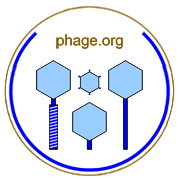

Process during phage adsorption whereby a virion adheres to the surface of a bacterium.
CAUTION: POTENTIALLY AMBIGUOUS TERM
Describes the non-phage-movement (mass action) aspects defining the phage adsorption constant. This attachment can be reversible or irreversible with these steps occurring in the order listed assuming that a reversible attachment step occurs. Usage, however, is not consistent.
The bacterial molecule or molecules to which the phage attaches are surface proteins, carbohydrates, or glycocalyx and these serve bacteria in ways that have nothing to do with phage attachment though nonetheless the bacterial molecules to which phages attach often are referred to a "phage receptors". Attachment involves specific interactions between proteins associated with phage virion particles and molecules found on bacterial cell surfaces. A substantial amount of the specificity of phage infections and thereby the breadth of phage host range is determined by the attachment step of phage infection.
Adams (1959) notes (p. 149) that "Adsorption necessarily involves an initial, reversible attachment. Reversibly adsorbed phage may desorb, or become irreversibly attached…" Similar wording can also be found in Stent (1963), p. 93.
For more on this topic, see Wikipedia, Google, and PubMed. Contact web master. Return to terms.











